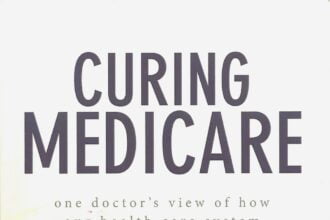Your diligence and foresight have enabled you to enjoy life, create memories, and invest for a comfortable retirement. Now you need to educate yourself on the best insurance coverage for your present, and future health care needs in order to avoid financial hardship resulting from unforeseen medical expenses after the age of 65.
As you probably already know, Medicare won’t cover all of your healthcare costs. Medicare Part A pays for about 80% of inpatient care, while Medicare Part B pays for about 80% of outpatient care, including medically required supplies. You can get Medigap insurance from a commercial insurance provider to cover the remaining 20% of your medical expenses.
Here’s what you need to know when comparing options.
What Are the Different Types of Medicare?
Let’s start with Original Medicare. Original Medicare is made up of Medicare Parts A and B. Part A provides coverage for hospitalizations, hospice care, some skilled nursing facility care, and home health care. Part B provides physician and outpatient services, as well as preventive care. Government cost-sharing is in place for both parts A and B.
As an alternative to Original Medicare, commercial insurers provide Medicare Advantage programs. Medicare Advantage plans, sometimes referred to as Medicare Part C, may include additional benefits such as dental and vision care. In addition, prescription drug coverage under Part D is included in the majority of Advantage plans. Each insurance company sets its own rate for cost-sharing.
Private insurers are also responsible for administering Medicare Part D prescription drug coverage. This is an optional plan that provides coverage for prescription medications.
Medicare Supplement Insurance, also known as Medigap, is designed to cover some of the expenditures that Original Medicare does not.
What Is Medigap?
Medigap, also known as Medicare Supplement, is a private insurance policy that can be bought to help pay for things that Original Medicare doesn’t cover. These secondary coverage plans are only available with Original Medicare. All other kinds of insurance, including commercial policies, stand-alone Medicare plans, and Medicare Advantage are excluded.
Prescriptions are typically not included in Medigap plans, so you should consider enrolling in Medicare Part D or a Medicare Advantage plan that does include them.
Medigap should not be confused with Medicare Advantage (Medicare Part C). While a Medicare Advantage plan can be used to supplement Medicare Parts A and B, Medigap only covers what Parts A and B do not.
Who Is Eligible for Medigap?
You’re eligible for Medigap if you are already enrolled in Original Medicare Parts A and B and don’t have a Medicare Advantage plan. You must also meet one of the following conditions:
- Be over the age of 65;
- Be under the age of 65 and on disability benefits;
- Have an ALS diagnosis;
- Have an ESRD diagnosis.
If you didn’t have creditable coverage, meaning other health insurance, prior to enrolling in Medicare, companies may delay coverage for a pre-existing condition for up to six months.
Your open enrollment period for Medigap coverage begins the month after you enroll in Medicare Part B insurance at 65 or older, even if you had group health insurance and didn’t sign up at that time. As long as you continue to pay your premiums, the insurance provider is not allowed to cancel your Medigap policy, even if your health status changes. If you already have Medigap coverage, you can apply to switch plans.
Medigap Comparison
In order to compare Medicare supplement plans, you need to know that there are ten standardized Medigap plans, denoted by the letters A through N and that plans with the same letter must have the same basic benefits regardless of insurer. This means that all plans with the letter A, for instance, will provide you with the same benefits no matter what insurance company you buy from.
However, premiums will differ from one insurer to another depending on how they set their rates, so you’ll find many companies offering the same plans at different prices.
When selecting a plan, you’ll want to consider your financial situation as well as your health. Here are some questions to think about as you look for the best option for your needs:
- Is basic coverage enough, or do I need more?
- In terms of out-of-pocket costs, what is it that I want help with?
- When visiting doctors that don’t accept Medicare payment terms, do I want assistance with the Part B excess charges I’ll face?
- Do I frequently go abroad and need international coverage?
- Is a high-deductible health insurance plan right for me?
Plan A provides the most basic level of coverage with the least amount of coverage. Plan F and G provide almost all available benefits if you need extra coverage. Plans K and L may be the best options if you want to keep your early Medicare out-of-pocket costs under control. If you want to travel outside of the United States, the best Medicare Supplement Insurance plans to look at are C, D, F, G, M, or N.
Bear in mind that you may no longer be able to buy plans C and F if you become eligible for Medicare on or after January 1, 2020. Plan F is the most comprehensive plan you can get and includes one additional benefit over Plan G, namely the Part B deductible.
Plan G has higher premiums than Plan N since it provides additional coverage. Depending on your medical demands, out-of-pocket costs with Plan N may equal or surpass premium differences with Plan G.
Plan N may be a more cost-effective alternative than Plan G if you are relatively healthy and do not visit the doctor often. Plan G is likely to be more cost-effective than Plan N if you visit the doctor once a month.
If you want a high-deductible plan, you can get plans F and G, but not every insurance company offers them, and, as we explained, you need to make sure you are eligible for plan F. As of 2021, you’ll have to pay up to $2,370 for Medicare coinsurance, copays, and deductibles before your insurance kicks in.
Plan G and Plan N do not pay the Part B deductible, which will be $233.6 in 2022.
Plan N will cover 100% of your Part B coinsurance, with the exception of copays of up to $20 for some office visits and up to $50 for emergency department visits that do not result in hospitalization.
Once you’ve determined which plan would meet your needs the best, you can start comparing pricing and read customer reviews for various insurance providers.










